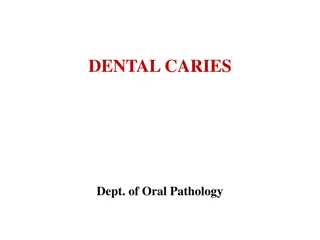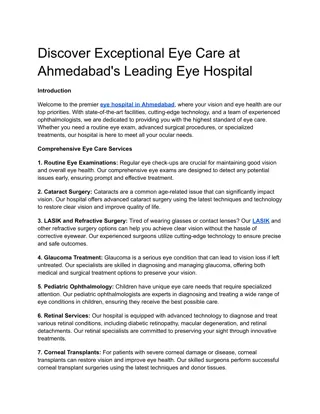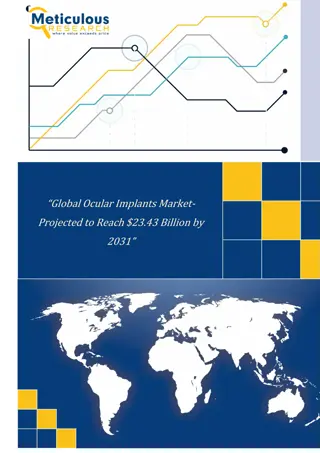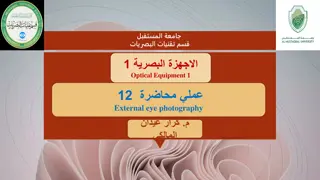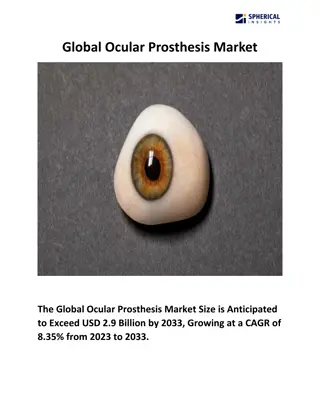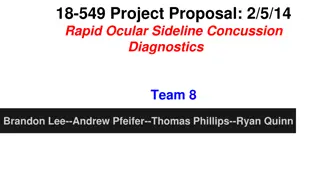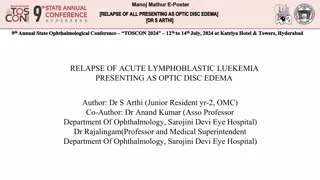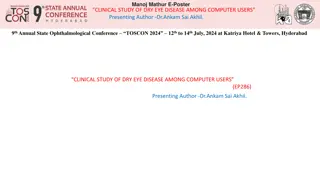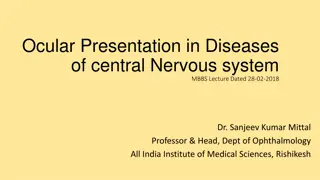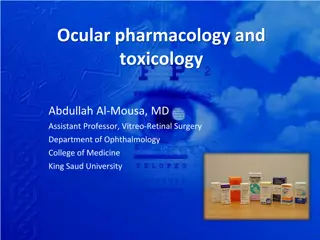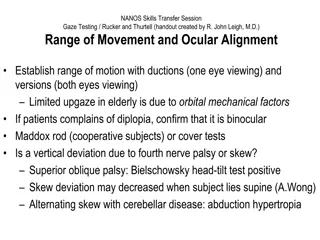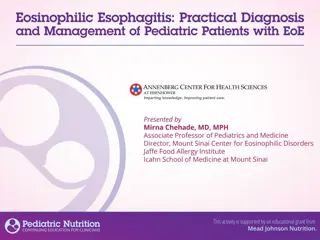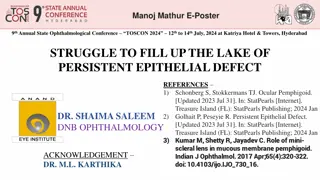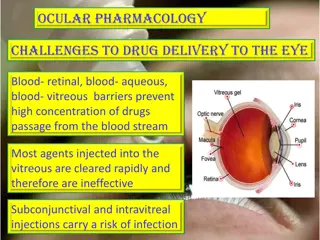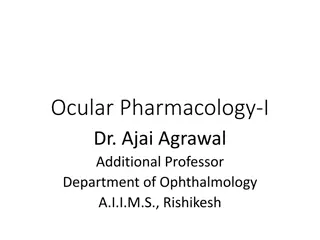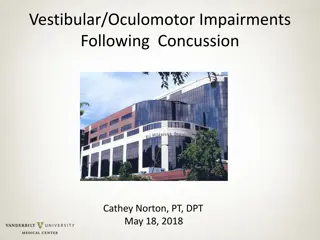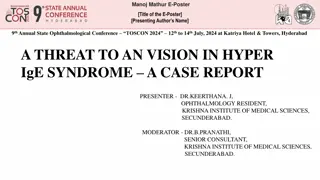Equipment Management - LABS FOR LIFE PROJECT - INDIA
Histopathology and cytology equipment, focusing on the tissue processor, important parts, maintenance, and steps in tissue processing. Understand the significance of these tools in the microscopic examination of tissues for disease manifestations.
5 views • 30 slides
Staining techniques
Explore a series of images illustrating various staining techniques used in histopathology, including fixation, different types of staining methods like Gram staining and acid-fast staining, as well as vital and supra-vital staining. Learn about the principles and applications of these techniques in
2 views • 42 slides
The lacrimal system
Disorders of the lacrimal system can lead to chronic symptoms affecting the eyes, causing discomfort and vision problems. Common abnormalities include dry eye, which can result from tear flow and evaporation issues. Aqueous-deficient dry eye, often associated with Sjögren's syndrome, is characteriz
3 views • 38 slides
Advances in Ocular Proton Therapy Treatment Planning
Explore the intricate world of ocular proton therapy treatment planning with Dr. Linda Mortimer, PhD. Discover the fundamental elements of an ocular treatment plan, main goals of treatment planning, an overview of dedicated ocular Treatment Planning Systems (TPS), planning workflows, choice of TPS,
4 views • 12 slides
Enamel Caries: Zones and Histopathology
Enamel caries is examined through histopathology, revealing four distinct zones - Translucent, Dark, Body, and Unaffected. Each zone presents unique characteristics, such as pore formation and light absorption. Understanding these zones is crucial for identifying and describing enamel caries accurat
1 views • 16 slides
Comprehensive Eye Care Solutions | Optimal Vision & Health
Discover our comprehensive eye care solutions designed to enhance your vision and overall eye health. From routine exams to advanced treatments, we provide personalized care for all your ocular needs. Schedule your appointment today for a brighter, clearer future.\n
0 views • 3 slides
Global Ocular Implants Market-Projected to Reach $23.43 Billion by 2031
Ocular Implants Market Size, Share, Forecast, & Trends Analysis by Type (Scleral, Stock, Orbital, Intraocular, Retinal, Corneal) Material (Silicon, Hydroxyapatite) Application (Prosthesis, Ocuplasty, Glaucoma Surgery) End User \u2013 Global Forecast to 2031\n
1 views • 4 slides
Principles of Staining in Histopathologic Techniques
Beginning with an introduction to staining in biochemical techniques, this chapter delves into the types of stains, factors influencing selectivity, and commonly used stains in histopathology. Learning objectives include defining staining, discussing dye-tissue affinity, understanding selectivity fa
2 views • 107 slides
South East England Histopathology EQA Scheme Meeting - November 30, 2022
South East England General Histopathology EQA Scheme Case Discussion Round is scheduled for Wednesday, November 30, 2022. The meeting entails review of cases, meeting etiquette, terms of reference, and round review. Participants are expected to engage by muting mics when not speaking, following meet
0 views • 20 slides
Guide to Optometry Schools and Application Process
Explore the world of optometry with a detailed guide on the application process, available schools in Ontario, Quebec, and the USA, and the responsibilities of optometrists. Learn about the Doctor of Optometry degree, where you can study optometry, and a comprehensive list of schools in the USA offe
1 views • 53 slides
South East England General Histopathology EQA Scheme Case Discussion Round
Meeting scheduled on Wednesday, March 23, 2022, for the South East England General Histopathology EQA Scheme Case Discussion Round. The agenda includes case reviews, meeting etiquette, terms of reference, and round r review details. Participants are expected to follow meeting protocols, engage in ca
0 views • 20 slides
Canine Infectious Hepatitis (ICH) - Overview, Symptoms, and Treatment
Canine Infectious Hepatitis (ICH), also known as Rubarth's Disease, is caused by Canine Adenovirus-1 (CAdV-1), affecting dogs of all ages. The virus primarily targets hepatocytes, leading to acute hepatitis, as well as respiratory and ocular issues. Transmission occurs through contact with infected
6 views • 7 slides
Ocular Herpes Virus: Pathogenesis, Mechanism of Action, and Clinical Features
Herpes viruses are common human pathogens causing both asymptomatic infection and active disease. Ocular herpes, typically caused by HSV-1, presents with symptoms like pain, photophobia, and blurred vision. Factors like UV rays, trauma, and stress can trigger reactivation. Recurrent infections often
2 views • 33 slides
Updates on Belamaf in Multiple Myeloma: ASH 2023 Highlights
Explore the latest findings from the American Society of Hematology (ASH) 2023 Hybrid Congress regarding Belamaf in multiple myeloma, including real-world outcomes, safety and efficacy analyses, long-term treatment impacts, infection risk, ocular toxicity prevention, and more. Key presentations cove
0 views • 35 slides
National Histopathology Service for Organ Retrieval and Transplantation - Audit Findings
The need for a national histopathology service for organ retrieval and transplantation is highlighted, with a focus on the importance of histopathological analysis in assessing donor organ quality and identifying lesions for further investigation. The audit findings show the incidence of urgent hist
0 views • 17 slides
Advancements in Ophthalmic External Photography
Ophthalmic external photography, particularly external ocular photography (EOP), plays a vital role in ophthalmology practice by capturing images of the eye, ocular adnexa, and facial structures. It aids in documenting lesions, nerve anomalies, surgical outcomes, and disease progression. Digital pho
0 views • 17 slides
Global Ocular Prosthesis Market
\"The Global Ocular Prosthesis Market Size is Anticipated to Exceed USD 2.9 Billion by 2033, Growing at a CAGR of 8.35% from 2023 to 2033. \n\n\"\n
1 views • 5 slides
South East England General Histopathology EQA Scheme Case Discussion Round Q
The South East England General Histopathology EQA Scheme is holding a meeting on Wednesday, 8th December 2021 for case discussion and review. The agenda includes reviewing cases and preliminary scores, maintaining meeting etiquette, and discussing meeting terms of reference. Participants are reminde
1 views • 20 slides
South East England General Histopathology EQA Scheme Meeting Overview
The South East England General Histopathology EQA Scheme Meeting on Wednesday, 29th March 2023, covers case discussions, meeting etiquette, agenda items, round reviews, and guidelines for case consultation and merging. The meeting provides an educational opportunity for attendees to understand scori
0 views • 20 slides
Rapid Ocular Sideline Concussion Diagnostics Project Proposal
Proposed project aims to provide tools for trainers in sports to automate and expedite concussion testing using ocular nerve testing. The focus is on developing an automated eyeset to quickly assess players on the sideline, potentially returning them to the game faster. The project also aims to inte
0 views • 7 slides
Dermatological Case Presentation: Clinical Findings and Pathology Results
Detailed presentation materials for a dermatological case including case history, clinical skin examination findings, clinical photographs, histopathology results, and additional workup details. Emphasis on the importance of non-identifying information in presentations for discussion at the CDS Quar
0 views • 6 slides
South East England General Histopathology EQA Scheme Meeting
The South East England General Histopathology EQA Scheme meeting on Tuesday, 30th July 2024, is set to discuss cases, review scores, and address questions. The meeting will cover meeting etiquette, agenda topics, meeting terms of reference, and round Y review. Attendees are reminded of the education
1 views • 20 slides
Ocular Implants Market
Ocular implant market projected to hit $23.43 billion by 2031, growing at 6.1% annually. Fueled by rising demand for vision restoration treatments.\n\n
1 views • 9 slides
The Principles of Staining in Histopathology
Staining is a crucial technique in histopathology that involves adding specific dyes to biological substrates to visualize and differentiate cell and tissue components. This chapter covers the principles of staining, types of stains used, factors influencing staining affinity, and common stains empl
0 views • 43 slides
General Histopathology EQA Scheme in South East England
The General Histopathology EQA Scheme in South East England has been running for 20 years, allowing participants to test their diagnostic abilities. Participants select cases, provide diagnoses, and indicate confidence levels. The scheme is scored based on the accuracy of participants' responses. Th
0 views • 14 slides
Ocular to Imaginary Deixis in Greek Epigram
The seminar held at University College London on 16th May 2018 explored the transition from ocular to imaginary deixis in Greek epigrams. It delved into the significance of visual elements in ancient artifacts and inscriptions, shedding light on the evolution of contextual meanings within Greek art
0 views • 8 slides
Relapse of Acute Lymphoblastic Leukemia presenting as Optic Disc Edema at TOSCON 2024
At the 9th Annual State Ophthalmological Conference (TOSCON) in 2024, Dr. S. Arthi presented a case of a 21-year-old male with a history of Acute Lymphoblastic Leukemia (ALL) who experienced a relapse presenting as optic disc edema. Despite chemotherapy and being under remission, the patient develop
0 views • 6 slides
Clinical Study of Dry Eye Disease Among Computer Users
Dry eye disease (DED) is a common ocular condition, particularly among computer users due to factors like decreased blink rate, environmental conditions, and visual display terminal use. This clinical study by Dr. Ankam Sai Akhil aims to assess the prevalence, causative factors, awareness, and risk
0 views • 6 slides
Ocular Presentation in Diseases of Central Nervous System - MBBS Lecture
Ophthalmologist Dr. Sanjeev Kumar Mittal from AIIMS Rishikesh discusses the ocular manifestations of intracranial lesions, emphasizing the importance of early diagnosis by ophthalmologists. Symptoms include headaches, vision changes, seizures, and more, while signs may include visual field defects,
0 views • 32 slides
Ophthalmology MCQ Sample Questions for Veterinary Ophthalmologists
Explore a set of multiple-choice questions related to veterinary ophthalmology, covering topics such as ocular anatomy, embryonic development, special features in different animals' eyes, diagnostic techniques, and lesion location in cases of anisocoria. Test your knowledge with these informative qu
0 views • 22 slides
Ocular Pharmacology: General Principles and Drug Delivery
The study of ocular pharmacology involves understanding general pharmacological principles, pharmacodynamics, and pharmacokinetics. Drugs can be delivered to ocular tissue locally via eye drops, ointments, injections, or systemically through oral or intravenous routes. Factors such as drug concentra
0 views • 58 slides
Techniques in Ocular Examination for Gaze and Visual Fixation
Explore various techniques for assessing ocular alignment, range of motion, and eye movement in patients through sessions focusing on gaze testing, visual fixation, saccades, and smooth pursuit. Learn how to identify abnormalities such as nystagmus, saccadic movements, and pursuit asymmetries to aid
0 views • 6 slides
Eosinophilic Gastrointestinal Diseases in Pediatric Patients
This educational material covers the clinical presentation, causes, allergic histopathology, immunopathogenesis, and management options for pediatric patients with eosinophilic esophagitis (EoE). Expert insights are provided on defining EoE, discussing etiology, diagnosing EoE, demographics, and the
0 views • 63 slides
Managing Ocular Cicatricial Pemphigoid: A Case Study from TOSCON 2024
A 64-year-old female presented with ocular symptoms, diagnosed with Ocular Cicatricial Pemphigoid at the 9th Annual State Ophthalmological Conference (TOSCON) 2024. Treatment included topical lubricants, anti-inflammatory agents, immunomodulators, and mini-scleral lens fitting. The patient showed sy
0 views • 6 slides
Overview of Renal Tumors: Benign and Malignant Forms
Explore the spectrum of renal tumors, from benign papillary adenomas and oncocytomas to malignant renal cell carcinomas like clear cell carcinoma. Images and descriptions showcase the gross pathology and histopathology of these tumors. Learn about the features and prognosis of different renal tumor
0 views • 31 slides
Challenges and Strategies in Ocular Drug Delivery
Ocular pharmacology faces challenges in effective drug delivery due to blood-retinal, blood-aqueous, and blood-vitreous barriers that impede high drug concentrations in the eye. Various routes of administration, including topical and local injections, are employed to overcome these barriers. Pharmac
0 views • 27 slides
Ocular Pharmacology - An Overview by Dr. Ajai Agrawal
Explore the intricate world of ocular pharmacology with Dr. Ajai Agrawal, an Additional Professor at A.I.I.M.S., Rishikesh. The learning objectives cover pharmacokinetics, pharmacodynamics, and various routes of drug administration in ocular treatments. Delve into the anatomy of the eye, tear film c
0 views • 51 slides
Vestibular and Oculomotor Impairments Post-Concussion
This presentation discusses common vestibular and oculomotor impairments following a concussion, highlighting the importance of the Vestibular/Ocular Motor Screening Assessment in identifying and monitoring concussions. It covers evaluation techniques for the vestibular system, interventions for ocu
0 views • 69 slides
Ocular Melanoma: Symptoms, Diagnosis, and Treatment
Ocular melanoma is a type of cancer that affects the eye, specifically the iris, ciliary body, or choroid. This type of melanoma originates from pigment cells within the uvea of the eye. Symptoms may include blurred vision, flashes of light, shadows, and more. Diagnosis typically involves an eye exa
0 views • 20 slides
Vision Threat in Hyper IgE Syndrome: A Case Report
Hyper IgE Syndrome (HIES) is a rare primary immunodeficiency characterized by elevated IgE levels and recurrent infections. Ocular involvement in HIES is uncommon, with reported cases of various eye conditions such as conjunctivitis and retinal detachment. A 17-year-old male with HIES presented with
0 views • 6 slides




